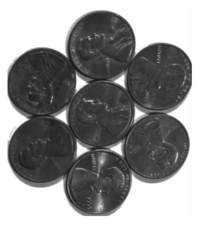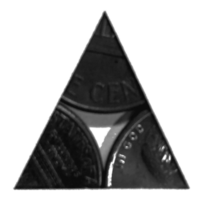Sphere Packing Basics
Author: Eli LeChien
A Warm-Up Exercise
To gain understanding Kepler's solution, it is first useful to define exactly what is meant by a “packing density.” A packing density is the proportion of space that is occupied by a specific arrangement of shapes. Essentially, Kepler said that when it comes to getting spheres as close as possible, 26% will be empty space. But, how did Kepler calculate this? To get an idea, one can redefine the problem with reduced dimensions; what’s the maximum possible density that disks can have without any overlap?
To solve this problem, one could take a stack of pennies and a table, lay out the pennies, and slide them around into various arrangements. It could be observed that a viable “strategy” is to align pennies around a central penny, resulting in the arrangement in Figure 1. Imagine this structure is repeated many times; what is the packing coefficient then? It can be seen that the empty space between three pennies is the same for any chosen triplet. If a representative structure is found containing these spaces, one could calculate the area of the pennies in the structure, and the area of the entire structure. Dividing these yields the packing coefficient. Figure 2 shows a representative unit structure for penny packing.
Figure 1: A Hexagonal Packing of Pennies
Figure 2: Representative Penny Packing Unit
With some thought, one could visualize how a large structure of pennies containing many conjoined septuplets of pennies in the arrangement of Figure 1 could be further decomposed into units of Figure 2. Take a second, convince yourself of this; imagine the center of the hexagonal packing, and add representative units with one triangle vertex touching the center where they fit. This is representative structure works well for this problem, as it contains the regularly repeated empty space that is seen in Figure 1. It can easily be seen that each representative penny-packing unit is an equilateral triangle. Because each angle is 60 degrees, each penny sector must be a sixth of a circle. Therefore, there is half a penny in the figure. Each side of the triangle is composed of two half pennies, and is therefore one penny long. Now, the packing density can be found.
Figure 2: Representative Penny Packing Unit
The area of an equilateral triangle with side s is:
$ A_{triangle}=\frac{\sqrt{3}}{4}s^{2} $
The area of a penny semicircle with radius r is:
$ A_{pennies}\ =\ \frac{1}{2}\cdot\pi r^{2} $
Knowing that r is half a penny unit, and s is a full penny unit, divide the area of the pennies by the area of the triangle. The packing density $ \eta_{pennies} $ is:
$ \eta_{pennies}=\ \frac{A_{pennies}}{A_{triangle}} $
$ \eta_{pennies}=\ \frac{\frac{1}{2}\cdot\pi\cdot\left(\frac{1}{2}penny\right)^{2}}{\frac{\sqrt{3}}{4}\cdot\left(1\ penny\right)^{2}} $
$ \eta_{pennies}=\ \frac{\pi}{2\sqrt{3}}\approx90.69\% $
This is by no means a rigorous proof, but does give a key insight into how these “closest packing” problems can be made simple: find a reasonable structure, then imagine what representative packing unit could be used to form the complete structure if it were repeated many times.



